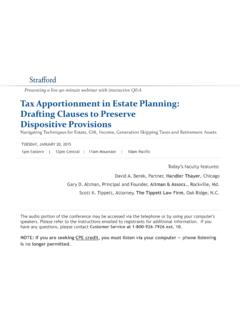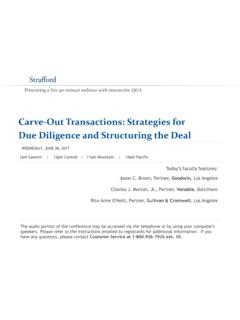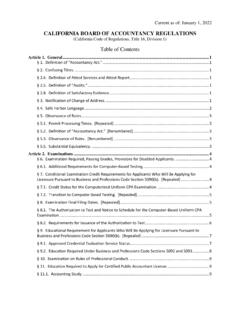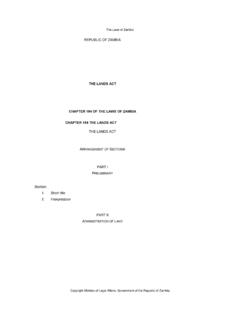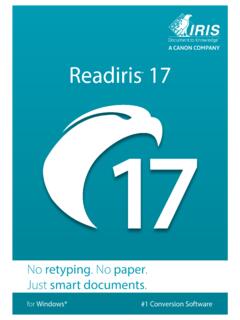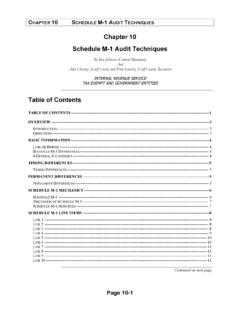Transcription of Liquidation of S Corporations: Mastering Tax Implications ...
1 WHO TO CONTACT For Additional Registrations: -Call Strafford Customer Service 1-800-926-7926 x10 (or 404-881-1141 x10) For Assistance During the Program: -On the web, use the chat box at the bottom left of the screen If you get disconnected during the program, you can simply log in using your original instructions and PIN. IMPORTANT INFORMATION This program is approved for 2 CPE credit hours. To earn credit you must: Participate in the program on your own computer connection (no sharing) if you need to register additional people, please call customer service at 1-800-926-7926 x10 (or 404-881-1141 x10).
2 Strafford accepts American Express, Visa, MasterCard, Discover. Listen on-line via your computer speakers. Respond to five prompts during the program plus a single verification code. You will have to write down only the final verification code on the attestation form, which will be emailed to registered attendees. To earn full credit, you must remain connected for the entire program. Liquidation of S Corporations: Mastering Tax Implications of Liquidating Distributions Case Study on Planning, Calculations, and Property Dispositions THURSDAY, OCTOBER 22, 2015, 1:00-2:50 pm Eastern Tips for Optimal Quality Sound Quality When listening via your computer speakers, please note that the quality of your sound will vary depending on the speed and quality of your internet connection.
3 If the sound quality is not satisfactory, please e-mail immediately so we can address the problem. Viewing Quality To maximize your screen, press the F11 key on your keyboard. To exit full screen, press the F11 key again. FOR LIVE EVENT ONLY Oct. 22, 2015 Liquidation of S Corporations Robert W. Jamison Robert W. Jamison, CPA Leslie Ellen Boyd CliftonLarsonAllen Amanda Wilson Lowndes Drosdick Doster Kantor & Reed Notice ANY TAX ADVICE IN THIS COMMUNICATION IS NOT INTENDED OR WRITTEN BY THE SPEAKERS FIRMS TO BE USED, AND CANNOT BE USED, BY A CLIENT OR ANY OTHER PERSON OR ENTITY FOR THE PURPOSE OF (i) AVOIDING PENALTIES THAT MAY BE IMPOSED ON ANY TAXPAYER OR (ii) PROMOTING, MARKETING OR RECOMMENDING TO ANOTHER PARTY ANY MATTERS ADDRESSED HEREIN.
4 You (and your employees, representatives, or agents) may disclose to any and all persons, without limitation, the tax treatment or tax structure, or both, of any transaction described in the associated materials we provide to you, including, but not limited to, any tax opinions, memoranda, or other tax analyses contained in those materials. The information contained herein is of a general nature and based on authorities that are subject to change. Applicability of the information to specific situations should be determined through consultation with your tax adviser. Orlando, Florida (407) 418-6220 Liquidation of S Corporations: Mastering Tax Implications of Liquidating Distributions Amanda Wilson October 22, 2015 Orlando, Florida | Treatment of Liquidating Distribution at S corporation Level 6 Orlando, Florida | Section 1371(a) Except as otherwise provided in this title, and except to the extent inconsistent with this subchapter, subchapter C shall apply to an S corporation and its shareholders.
5 As a result, the Liquidation provisions of subchapter C apply to S corporations. 7 Orlando, Florida | Section 336 Section 336 provides that a corporation will recognize gain or loss on the distribution of property in complete Liquidation of the corporation as if the property were sold at fair market value. Consequences of (i) sale of assets by S corporation with distribution of cash proceeds to shareholders, or (ii) in-kind distribution of S corporation assets to shareholders are therefore generally the same. Any appreciation in the S corporation will be triggered and recognized as a result of a Liquidation .
6 This is a significant difference from partnerships. 8 Orlando, Florida | Example ABC Inc., an S corporation , owns a building with a basis of $500. ABC sells the building for $1000. ABC recognizes $500 of gain [$1000 amount realized less $500 basis] under Section 1001(a). Assume instead that ABC distributes the building to its three shareholders - A, B, and C. ABC is treated as selling the building for $1000, its fair market value, under Section 336. As a result, ABC recognizes $500 of gain. 9 Orlando, Florida | Rules to Watch Out For If property taken subject liability, the fair market value is treated as no less than the amount of the liability.
7 No loss recognized under Section 336(d) on distributions to related person (within meaning of section 267) if (i) not pro rata or (ii) disqualified property (property acquired in certain Section 351 transactions within 5 years of the distribution). Ordinary income on Sections 1245 or 1250 depreciation recapture. Ordinary income under Section 1239 if depreciable property distributed to related person. 10 Orlando, Florida | Shareholder s Treatment of Corporate Items Section 1366 generally provides that S corporation shareholders report their pro rata share of the S corporation s tax items on their personal returns (Schedule K-1).
8 Section 1367 provides that the S corporation shareholders get a basis adjustment for their pro rata share of the S corporation s tax items. The result is that S corporations are generally pass-through entities like partnerships, with a single layer of tax. 11 Orlando, Florida | Built-in Gains Tax Built-in gains tax is an important exception to the pass-through treatment for S corporations. The concern was that C corporations could otherwise convert to an S corporation shortly before it planned to sell assets, thereby avoiding the double layer of tax. In most general terms, the tax is imposed on any gains built-in at the time of the S election if recognized by the S corporation within ten years of the conversion.
9 The tax is imposed at the highest corporate tax rate (35%). Schedule D (1120-S), Part III. 12 Orlando, Florida | recognition Period The built-in gains tax applies to any taxable year that begins during the recognition period. Section 1374(a). The recognition period is the ten year period beginning with the first day of the first taxable year for which the corporation was an S corporation . Section 1374(d)(7). Special shorter periods for 2009 -2010 (seven years) and for 2011-2014 (five years). S corporation Modernization Act of 2015 ( 2788) proposes reducing recognition period to five years.
10 13 Orlando, Florida | Net Recognized Built-In Gain The tax is 35% of net recognized built-in gain. Section 1374(b). Net recognized built-in gain is the lesser of: The amount of taxable income that the S corporation would have in a taxable year if only recognized built-in gains and recognized built-in losses were taken into account, or The S corporation s taxable income for such taxable year. If recognized built-in gain exceeds taxable income, the excess built-in gain is carried over and treated as recognized built-in gain in the next taxable year. 14 Orlando, Florida | Recognized Built-in Gain or Loss Recognized built-in gain or loss is the gain or loss recognized during the recognition period on the disposition of any asset except to the extent that the S corporation can establish: the asset was not held on first day that the corporation elected S status, or such gain exceeds the excess (if any) of the FMV of the asset on the first day of the corporation s first S status year over the adjusted basis of the asset on that day (or converse for losses).






